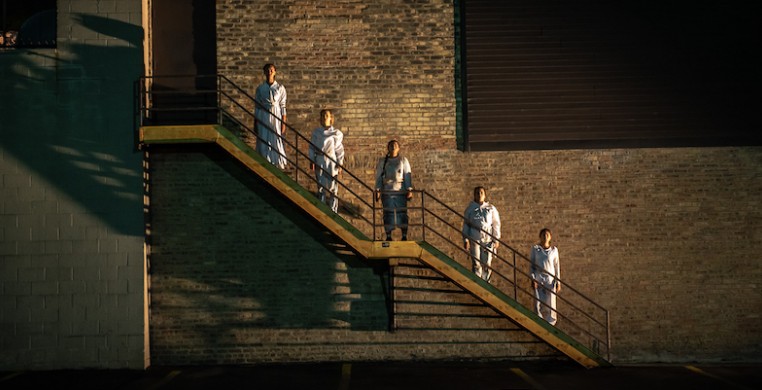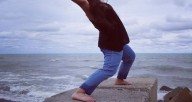With warnings of another potential lockdown on the horizon, dancers and choreographers are getting creative with how they present their work. Going virtual has been the obvious choice— although not the preferred one for many—and live performances must be carefully managed. Fortunately, choreographer MaryAnn McGovern has ‘carefully managed’ as one of her skill sets.
McGovern directed “Heat Lighting” this weekend’s premiere performance of the Contretemps Contemporary Ballet company. Carefully managed is right: The performance is open air and the audience is spread out on metal risers; the wearing of masks and proof of vaccination are required for entry. The hour-long performance is set in the parking lot of the Drucker Center on Chicago’s North Side, sprawling in its width and depth and made of hard and unforgiving blacktop. But this radical space suits the company, who describe themselves as an “intrinsically radical…feminist, anti-racist, anti-patriarchial, pro-worker, LGBTQIA+-affirming organization.” McGovern’s use of this non-traditional space is out-of-this-world good, even if the subject matter can be, at times, a little too down to earth.
At just before dusk, a procession of five lantern bearers enters from seemingly out of nowhere and lines up horizontally. One of them breaks rank and an occult-like initiation begins. The initiate runs one at a time to each of the stoic figures and capsizes to the ground in front of them, arms swirling in concentric circles as she spirals to the ground. In response, the stoic figures dim and brighten their lanterns in approval, or possibly condemnation, as the pleading figure runs back and forth, her shoes clomping loudly on the pavement as she throws herself at their feet.
The quintet then transforms themselves into scientists, their loose white-cloth robes turning into stiff lab coats with the simple addition of plastic safety glasses and starker lighting—subtly managed by lighting designer Jacob Snodgrass. Set to a soundtrack of cascading glass and rolling synth-loops, they each pick up colored bottles and, like human laboratory shakers, do their best to disturb the bottles’ contents with swirling movements until, seemingly dissatisfied, they hurl them against the weathered brick wall behind them, shattering them, and breaking down into thin strips on the ground before slowly rolling off to the sides.
Throughout the performance, the sounds of the city insert themselves in contrast to the action being performed. The generally trance-like music that accompanies the first half of the performance is undercut by loud punk rock pouring out from a nearby bar. At one point, the company forms a tight cloister that crouches low with swinging pelvic isolations back and forth creating a pleasing phalanx of grotesque shapes—meanwhile, a party of restaurant-goers enjoying the free-to-them performance on an adjacent rooftop whoop, laugh and scream, clearly bemused and childishly delighted by the avant-garde aesthetic of the performance. Does this affect the dancing? Not at all. And I must give kudos to the dancers, whose unflinching focus effectively fought back against any outside and audible interlopers.
Oh, but what a wonderful world that has, so far, been constructed in my mind. Occultists, dystopian scientists, a writhing phalanx… each piece thus far providing ample fuel for my imagination, which is slightly dismembered when, one by one, the company pours buckets of plastic detritus onto one of their own. What else can this be taken for except for commentary about plastic waste, of which I, personally, am a big proponent against. But did it have to be so literal when the rest of the performance has been so abstract? Flung and shattering bottles could be a bunch of different things, real and fictitious, but a person being literally hit over the head with garbage leaves nothing to the imagination and nothing for me to figure out for myself—even though I agree with the sentiment, one hundred percent.
The company is best when sticking to the abstract. One highlight of the performance begins with a figure cross-legged on the ground in deep meditation while another figure, seemingly frozen and inanimate, is carted out and set up like a storefront mannequin. As the meditative figure begins to move, so does the mannequin, becoming increasingly stiff until the two are rolling around together in the dirt, their movements indistinguishable from another, until they again separate. But the original is now rigid and the copy takes her place downstage—so who was really the doppelganger?
A similar piece finds a quartet lined up diagonally across the asphalt and moving in tandem, only to split into two couplets, each maintaining constant contact with their partner—chests pressed together, arms intertwined and heads resting on each other’s shoulders, until the bodies again merges into one monstrous and writhing mass. I feel like I am watching a Phillip K. Dick story, or perhaps a John Carpenter horror movie. These bits create magnificent narratives.
The unusual outdoor environment is used to great effect: Dancers at once ascend a large, yellow-metal staircase deep in the background, creating a scene that is both industrial and socially hegemonic, oppressive and sad. Set in front of a spindly tree, the company clumps together gradually. Their arms reach skyward from a crouched position, the angles of the elbows and the curves of their fingers almost exactly recreating and superimposing themselves against the curling branches behind them. A Hollywood-style special effect is achieved when they run all the way to the back wall, which is far enough to drastically dimmish their size, and a miniscule figure is lifted to perform a gravity-defying, circular wall-walk, effectively making it appear as if we are observing them from a lofty position high overhead—an amazing, vertigo-inducing effect.
The performance ends with another earthly-appeal to social justice (I think)—or it could be politics or environmentalism—as a cluster of dancers performs a mocking, tongue-in-cheek, prancing jig while two others hold up signs that say “Ch.1, We F*cked Up”, “Ch.2, We did it again and again and again and again” and finally “Ch.3, Didn’t say sorry.” Where at once I was floating in a dream world, now I am on a snarky Facebook message board.
Aside from a few overt anchors to bland reality, this thoroughly enjoyable performance serves as a profound reminder that creativity and ingenuity, pruned by world events, are in the throughs of regrowth. More than that, the level of experimentation found in “Heat Lighting” doesn’t just bring us back to the status quo but progresses bravely forward and in new directions.
--
“Heat Lightning” has two more performances on Aug. 21 and 28 in the parking lot of the Drucker Center, 1535 N. Dayton St. Proof of vaccination and the wearing of masks are required. For tickets or more information, visit the event page below.


